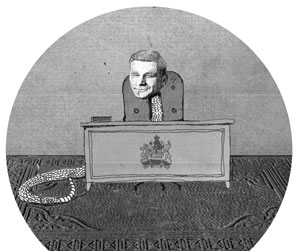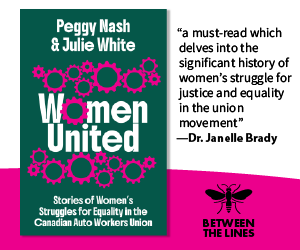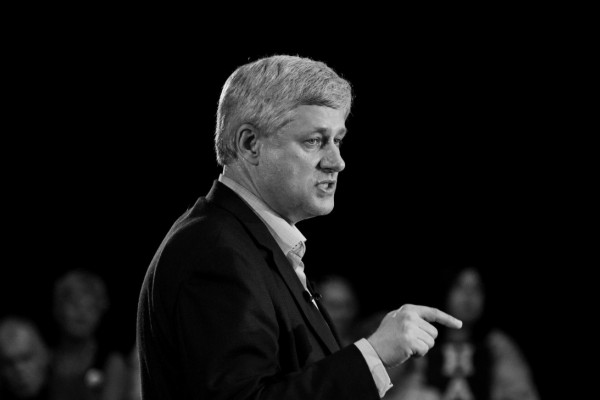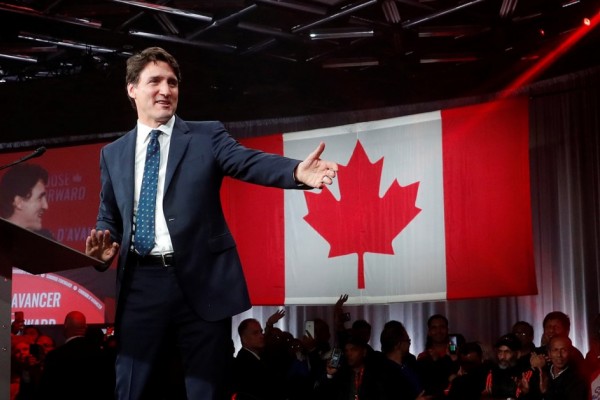Figuring Out and Fighting Harper
The January federal election results unexpectedly yielded a minority Conservative government. The Great Moving-To-The-Right Show is having yet another run. In Prime Minister Stephen Harper, Canada now has the most ideologically committed neoliberal in power since Margaret Thatcher. The five priorities Harper has announced – an accountability package, a cut in the GST, a market-based childcare system, a law-and-order agenda centred on sentencing and a reduction in health-care wait times through increased delivery flexibility – all reflect these commitments. These proposals are embedded in the overall strategic priority of aligning Canada even more tightly with the U.S. through increased overseas military commitments and further economic integration. Canada’s takeover of the NATO command in Afghanistan and increased troop deployment is already sketching in the new terrain. It could hardly be more pressing for the Left to take stock of what the Harper government is and might become.
The Harper Advantage
It was evident on election night that Harper does not have the possibility of forging a stable Parliamentary majority. Neither the Liberals nor the NDP will want to underpin
the government. The Liberals will not easily shed their opinion of themselves as the “natural governing party”; while supportive of the neoliberal government of Paul Martin, the NDP will find holding up a Harper administration too shameful. As part of a federal coalition, the BQ would undermine its entire political rationale. Even in the compromising world of Canadian politics, some breaches of political faith are hard to envision.
The immediate strategy of the Conservatives will be to cobble together support in the House of Commons for Harper’s priorities on an issue-by-issue basis. This will give him a chance to stabilize key political constituencies, widen his political base and fashion a majority government the next time around.
Since the days of Thatcher, Reagan and Mulroney, the Left has consistently underestimated the political appeal of the New Right. Still under the spell of Keynesian thinking that governments alone can stabilize capitalism and maintain “fair” competition, or of the mechanistic Marxism forever invoking the final crisis of capitalism, the Left has continually mocked the capacity of neoliberalism to forge a stable policy regime and restore capitalist prosperity. These errors have been fatal. We should be more sober on the potential of the Harper government and the advantages he has in forging a new coalition.
While bumbling with respect to the appointments of Emerson and Fortier, the Conservative cabinet ministers on the whole have either already held government posts or have extensive other political experience. This will give them some capacity to gain a quick handle on the bureaucracy, to negotiate with the provinces in line with their priorities, and to push their agenda of closer ties to the U.S. on trade and security. The shrewd appointment of Mulroney’s old finance minister, Michael Wilson, as ambassador to the U.S., and the return of Kevin Lynch to Ottawa from the IMF to become clerk of the Privy Council, will facilitate this. The Conservatives will, perhaps, even get through parliamentary controversies over gay marriage and other issues of social conservatism without irreparable political damage.
Harper has also inherited a massive budgetary surplus that allows him plenty of initial elbow room to fulfill his promises of lowering taxes, raising military expenditures and financing his child-allowance scheme. Anticipated Canadian economic growth will also add to the fiscal room. Harper’s fixation on an alleged “fiscal imbalance” between levels of government will also likely involve some shifting of tax capacities to the provinces. This is all do-able in the short term, while creating conditions for further budgetary constraint in the future.
As well, the Conservatives have a beachhead in Quebec now, and, with the Liberals in such bad odour there – for years to come – there is room for the Conservatives to grow. There is no reason why they could not capture both the federalist and the old “conservative” nationalist vote the next time around. This is the old Mulroney base, and Harper will attempt to work co-operatively with Premier Jean Charest to reform it.
Finally, the parliamentary opposition will find ways to let Harper govern for at least 18 to 24 months. The Liberals are in disarray, and are slowly putting together what may well be a tumultuous leadership contest. The historical political figures that have been around since the Trudeau years are now finally all gone. The Liberals will do what they have to do either to support particular measures that the Liberals had already brought in (intervention in Afghanistan, closer ties to the U.S., increased use of P3s) or simply to abstain from votes to keep the Harper regime from falling. The Bloc will not be any quicker to jump the gun given their shoddy showing in the last election, when all should have gone their way. They are likely to support any measure that devolves power to the provinces and builds stronger economic ties with the U.S. – if only to advance the Bloc’s own goal of gaining greater political independence for Quebec. The NDP vote, for its part, doesn’t matter so long as Harper has the support (or abstention) of either the Liberals or the Bloc.
Potential Obstacles
A realistic assessment of the current terrain of Canadian politics cannot shrink from facing the possibility that a militantly neoliberal government under Harper might last and piece together the fragmented regional, capitalist and conservative interests into a stable coalition. They will be running with a sympathetic national press in the Globe & Mail and National Post, as well as broadcasters in the Global and CTV chains. The new corporate militancy emerging in collective bargaining will also be in line with what Harper has identified as priorities. There are, however, several obstacles that could emerge to dislodge the Conservatives.
If it is true that Harper’s cabinet has many political veterans, it is also the case that it is laced with Christian fundamentalists and pro-lifers. There are, in fact, nine publicly stated pro-lifers among the 26 cabinet ministers, or a third of the cabinet. They include, in addition to a cagily supportive Harper himself, Finance Minister Jim Flaherty, Agriculture Minister Chuck Strahl, Justice Minister Vic Toews, Fisheries Minister Loyola Hearn, Citizenship and Immigration Minister Monte Solberg, Minister for Democratic Reform Rob Nicholson, Public Safety Minister Stockwell Day, Natural Resources Minister Gary Lunn and National Revenue Minister Carol Skelton. Another pro-life MP of prominence passed over for a cabinet post, Diane Ablonczy, will be the parliamentary secretary to the finance minister.

Can Harper manage this bunch? They will be pushing a range of social-conservative measures. This may well involve a debate and open parliamentary vote on gay marriage. The social conservatives will be set against a range of others who adhere to a more libertarian position, who at least oppose making such issues a centrepiece of political mobilization, as they have become among the religious Right of all faiths in the U.S. A number of cabinet ministers, at least six of them by some counts, including Liberal turncoat David Emerson, do not adhere to the Conservative Party’s official policy in support of traditional marriage. Satisfying the religious fundamentalists and other social conservatives from the Reform wing of the Conservative Party will be an ongoing problem for Harper. The dilemma will be how to do so without destroying the possibility of building some kind of an urban base, where voters are inclined toward more liberal and egalitarian positions on these issues. Forwarding a socially conservative agenda will activate constituencies against Harper that were relatively quiescent in the election. This could already be seen in the International Women’s Day marches this March.
Several other policies of the Harper government will also be divisive. Enabling provinces to reduce wait times by further privatizing health care or reneging on prior childcare agreements with the provinces without generating massive popular resistance may prove difficult. The same goes for rescinding Liberal financial promises to Aboriginal peoples without creating a backlash.
Another possible contradiction stems from Harper’s conviction to end corporate subsidies, an integral component of his neoliberal philosophy and the reforming of the Conservative Party. Imperial Oil, for example, fully expects the Conservatives to fulfill the prior Liberal government’s promises of huge subsidies before it commits to the Mackenzie Valley Pipeline. General Motors and the rest of the automobile sector have been effectively leveraging both its workers and the government for concessions. Other giant companies in the transportation sector, like Bombardier, are always at the trough. And Canada is reaching a limit on its current energy infrastructure. With manufacturing being squeezed by the rising loonie and declining U.S. growth, there will be increasing pressure for federal government subsidies to corporations. This should give ample room for more critical perspectives on industrial policy and tax breaks to develop.
Finally, Harper is particularly vulnerable on his plans to develop closer trade, security and foreign-policy ties with the U.S. The Conservatives’ strong stance on Arctic sovereignty (the U.S. wants more Canadian military activity, here, in any case) is a bit of a ruse for deeper ties being forged everywhere else. These plans will inevitably also raise the deep skepticism about the U.S.’s imperial adventures and NAFTA that have already been exposed. With ample reason, the flames of anti-Americanism are likely to be fanned. Few Canadians will be impressed by Harper’s parrot-like “we don’t cut and run” jingoism. Most already suspect that Canada’s mission in Kandahar is not peacekeeping, but rather helping to impose U.S. rule over Afghanistan and safeguard routes for planned oil pipelines.
Fighting the Conservatives
It would be daft to deny or underestimate the changes a Harper Conservative government would bring to Canada. Neoliberalism has been the order of the day since the last Trudeau government of the early 1980s. It was the Liberals, after all, that delivered NAFTA in 1994, and just signed off on the WACO accord on behalf of Canada (however different they might sound in the months ahead). But there are different varieties of neoliberalism. Harper and the people around him are far more market utopians, social conservatives and followers of the American Empire than has typically been the case in Canadian governing parties. Despite NAFTA and the gutting of transfer payments and unemployment insurance by the Martin Liberals, aspects of the welfare state have not been totally smashed. Harper will have few qualms about fully breaking with universality and national standards, allowing the provinces to do as they will. And clearly he will vigorously pursue deeper integration into the continental political economy in energy, defense, security and border matters.
It is quite conceivable that the Conservatives can stickhandle through the many obstacles and pursue this agenda. They have a distinct advantage in a weakened Liberal opposition party with declining credibility in all regions of the country. This will intensify the competition between them and the NDP over becoming the leading centrist party in Canada, the goal that Layton has clearly set for the NDP and pursued in the last election with its “third way” embrace of more “market-friendly” and “law, order and security” policies. It will also increase the number of calls, already circulating in mainstream media like the Toronto Star and more progressive media like Rabble.ca, for the forging of a centre-centre alliance to block the Conservatives. Such an alliance could well block the Conservatives, but it would still leave us with neoliberalism and the all-party consensus tailing the American Empire into the Middle East and Haiti, and wherever else the U.S.’s “long war” might take us next. The Liberals are, in any case, very far off from ever conceding the centre track to the NDP. They have a base in Bay Street that the NDP will likely never acquire. The talk of an electoral coalition to stop a Harper majority will likely be stillborn.
Electoral forces are therefore likely to be similar in the next election. The NDP under Layton will continue to recast itself as a post-labour, market-friendly, urban, progressive party open to all sectors. They may help here and there with a campaign, but the NDP will contribute little to the processes of re-forming sustained anti-neoliberal forces.
The election campaign vividly recorded the impasses of other social forces in the present period. Unions and other social movements show themselves still to be disorganized and individualized. Various strategies of a “politics of chaos,” “multitude against empire,” “anti-power” and “coalition networks” have defined the social-justice movement since the 1980s. We can now clearly see that these strategies have reflected rather than challenged the atomizing social processes of neoliberalism.
The pivotal question for the Left in Canada is whether the social fractures that will emerge from Harper’s agenda can also be used to push into new organization building and strategic experimentation. There is ample ground for optimism, here.
The unions in Canada have, for example, held up better than those in many other countries against the neoliberal assault. However, they are now in a period of retreat under the new militancy of employers, with both the CAW and CUPE taking a range of concessions hits. Fightbacks in both unions are likely to unfold. The Harper government’s agenda should provide an opportunity to re-link struggles across the public and private sectors.
Such organizing could easily provide stronger linkages to the anti-privatization campaigns that will develop as the Harper government agenda develops. The health-care campaign against privatizations and P3s, for example, is already facing new fights in Alberta. Harper’s rejection of the daycare agreements with the provinces will also limit the development of a public system. These campaigns have enormous popular resonance, and could be aided by some systematic union mobilizations in support. The Left’s leadership, here, can make them solidly anti-neoliberal campaigns and embed an anti-capitalist element in them.
The increased military role of Canada in Afghanistan should provide another opening. Public sentiment is already largely skeptical of the troop deployment and Canada being involved in combat roles. Being foot soldiers of the American Empire is not exactly what Canadians have in mind for our foreign policy. The anti-war movement has enormous potential to become a focal point for organizing against imperial interventions, the new security agenda, the racist biases of immigration and border security and the deep-integration project.
The Left has built up very sizeable capacities to aid in these struggles. The alternative media and cultural resources have continued to develop in Canada in innovative ways. Against all odds, Marxist and critical thinking has developed in unexpected ways and places, firmly becoming embedded in Canadian intellectual and cultural life as, perhaps, its richest component. The Tory philistines that once defined Canada no longer go unchallenged. Alternate ways of thinking about social organization have never been greater in number. The next step is to reclaim the political and organizational capacities to match these developments. The coming struggles against the Conservatives could make a significant contribution.
This article appeared in the March/April 2006 issue of Canadian Dimension (Women Speaking Out).








